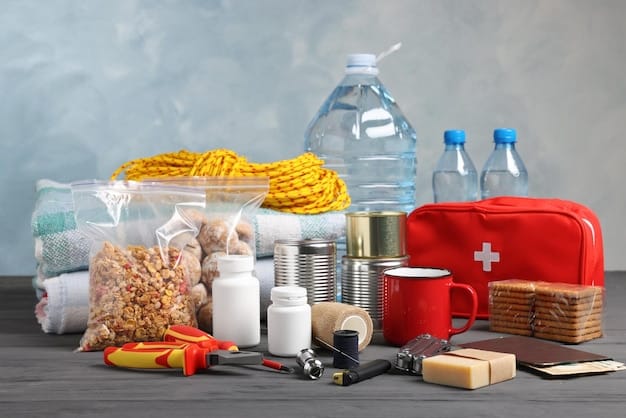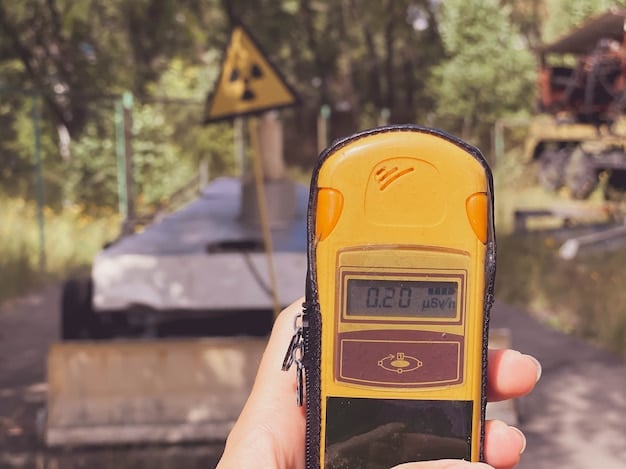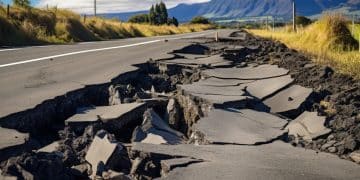Disaster Supply Kit 2025: Be Prepared for Anything

Creating a disaster supply kit tailored for 2025 involves assembling essential items like food, water, medical supplies, and communication devices to ensure your household can withstand various emergencies, from natural disasters to unforeseen crises.
Are you ready for the unexpected? **Creating a disaster supply kit: What Every US Household Needs in 2025** is more than just a precaution; it’s a necessity in an increasingly unpredictable world. Preparing now can make all the difference when disaster strikes.
Why a Disaster Supply Kit is Crucial for 2025
In 2025, the landscape of potential disasters is ever-evolving. From severe weather events to unexpected emergencies, being prepared is not just a suggestion—it’s a necessity. A well-stocked disaster supply kit can be the difference between weathering a crisis smoothly and struggling to survive.
Increased Frequency of Extreme Weather
Climate change is contributing to more frequent and intense weather events across the United States. Hurricanes, wildfires, floods, and tornadoes are becoming more commonplace, and their impact is growing. Having a disaster supply kit ensures you’re ready to face these challenges head-on.
Economic Uncertainties
Economic instability can disrupt supply chains and make it difficult to access essential resources during a crisis. A disaster supply kit helps mitigate these risks by providing a cushion of food, water, and other necessities.
- Peace of Mind: Knowing you’re prepared can reduce stress and anxiety during uncertain times.
- Self-Sufficiency: A kit allows you to be self-reliant when outside help is delayed or unavailable.
- Community Resilience: Prepared households contribute to the overall resilience of their communities.
Investing in a comprehensive disaster supply kit is an investment in your family’s safety and well-being. It’s a proactive step that can provide security and peace of mind in an uncertain world.

Essential Components of Your 2025 Disaster Kit
Building a disaster supply kit involves carefully selecting items that will help you survive for at least 72 hours, if not longer. Here are the essential components every US household should include in their 2025 disaster kit.
Water and Food
Water is the most critical resource in any survival situation. Storing an adequate supply is essential. Aim for at least one gallon of water per person per day. Non-perishable food items are equally important. Choose foods that are easy to store, require no cooking, and have a long shelf life.
Medical Supplies
A well-stocked first-aid kit can address minor injuries and illnesses. Include items like bandages, antiseptic wipes, pain relievers, and any personal medications.
- Water: One gallon per person per day for drinking and sanitation.
- Food: Non-perishable items such as canned goods, protein bars, and dried fruit.
- First-Aid Kit: Bandages, antiseptic wipes, pain relievers, and personal medications.
These essential items are the foundation of any disaster supply kit. Ensure you have enough to sustain your household for at least three days.
Advanced Tools and Technologies for 2025
In addition to the basics, consider incorporating advanced tools and technologies into your disaster supply kit. These items can enhance your preparedness and improve your ability to communicate and navigate during a crisis.
Communication Devices
Staying connected is crucial during a disaster. Cell phones can be unreliable due to power outages and network congestion. Consider alternative communication devices such as hand-crank radios and satellite phones.
Navigation Tools
If you need to evacuate, having reliable navigation tools is essential. GPS devices, maps, and compasses can help you find your way, even if electronic systems fail.
- Hand-Crank Radio: Stay informed with weather updates and emergency broadcasts.
- Portable Power Bank: Keep your devices charged without relying on electricity.
- GPS Device: Navigate effectively, even without cell service.
Incorporating these advanced tools into your disaster supply kit can significantly improve your ability to respond to and navigate through a crisis.

Customizing Your Kit for Specific Disasters
Different regions of the United States face different types of disasters. Customizing your kit to address the specific risks in your area is essential. Here’s how to tailor your kit for common disasters.
Hurricanes
If you live in a coastal area prone to hurricanes, include items like sandbags, plywood for window protection, and extra batteries.
Earthquakes
For those in earthquake-prone regions, include sturdy shoes, a whistle to signal for help, and a wrench to turn off gas and water lines.
Consider the specific hazards in your area and adjust your kit accordingly to ensure you’re prepared for anything.
Maintaining and Updating Your Disaster Kit
Building a disaster supply kit is just the first step. It’s crucial to regularly maintain and update your kit to ensure the items are still in good condition and haven’t expired.
Regular Inspections
Inspect your kit at least twice a year. Check expiration dates on food and medications, replace batteries, and ensure all items are in good working order.
Rotation of Supplies
Rotate your food and water supplies to prevent spoilage. Use a system like the FIFO (First In, First Out) method to ensure you’re using the oldest items first.
- Check Expiration Dates: Replace expired food, water, and medications.
- Replace Batteries: Ensure flashlights and radios are ready to use.
- Update Information: Review and update emergency contact lists and evacuation plans.
Regular maintenance and updates are essential to ensure your disaster supply kit remains effective and reliable.
Where to Store Your Disaster Supply Kit
The location of your disaster supply kit is just as important as its contents. Choose a storage location that is easily accessible, protected from the elements, and known to all family members.
Accessibility
Store your kit in a location that is easily accessible from anywhere in your home. A closet, basement, or garage are common choices.
Protection from the Elements
Protect your kit from extreme temperatures, moisture, and pests. Use airtight containers to keep food and supplies dry and secure.
By carefully selecting a storage location, you can ensure your disaster supply kit is ready when you need it most.
| Key Point | Brief Description |
|---|---|
| 💧 Water Storage | Store one gallon per person per day. |
| 🥫 Non-Perishable Food | Stock up on canned goods, protein bars, and dried fruit. |
| ⛑️ First-Aid Kit | Include bandages, antiseptic wipes, and pain relievers. |
| 📻 Communication Devices | Hand-crank radios and portable power banks are essential. |
Frequently Asked Questions
▼
The recommendation is to store at least one gallon of water per person per day for drinking and sanitation. Aim to have at least a three-day supply.
▼
Focus on non-perishable items that require no cooking, such as canned goods, protein bars, dried fruit, and ready-to-eat meals.
▼
It is recommended to inspect and update your kit at least twice a year, checking expiration dates and replacing any used or expired items.
▼
Choose a location that is easily accessible, protected from the elements, and known to all family members, such as a closet, basement, or garage.
▼
Consider adding a hand-crank radio, portable power bank, GPS device, and a satellite phone to enhance your preparedness and communication capabilities.
Conclusion
Creating a disaster supply kit is a proactive and essential step for every US household in 2025. By assembling the right supplies, customizing your kit for specific disasters, and maintaining it regularly, you can ensure your family is prepared to face any emergency with confidence and resilience.





